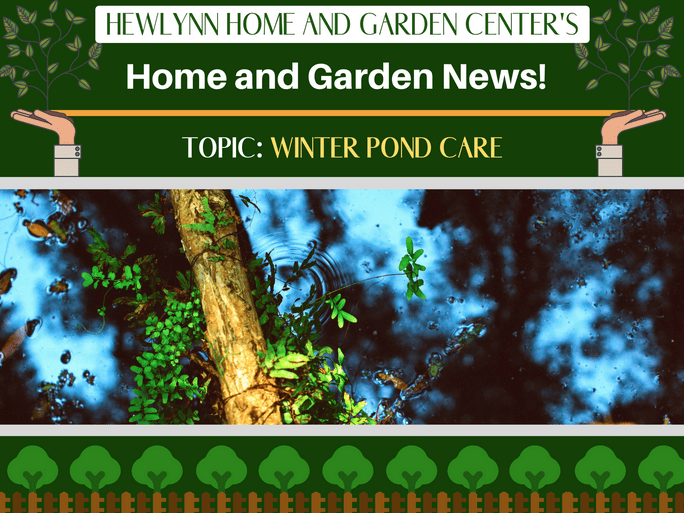As a pond owner it is our responsibility to tend to our ponds for the safety and care of our fish. This requires a little bit of preparation work as the seasons change. Winterizing your pond does not have to be a strenuous process. If you have not done so already, here are several steps you can take to minimize or avoid damage to your pond and to protect your fish.
- Remove your Pond Netting. Any debris or foliage collected by the net covering your pond should be removed and shaken off. If you were to keep it on the pond, heavy snow and ice would weight it down and endanger your fish.
- It is very important to switch your fish food over to a wheat germ based food during the spring and fall, which is easier for your fish to digest, and can be found here at our store. As the temperatures begin reaching 40 to 50 degrees Fahrenheit, STOP feeding your fish. A useful tool is a “Pond Temperature Indicator” (sold here at Hewlynn Home and Garden Center). Since there will not be a filtration process occurring during these winter months, any waste produced by the fish will not have an exit point and will accumulate within their water, rendering their water toxic. If you happen to have any fancy fishes such as tropical fish, they should be brought inside for the winter. You may want to check with your local fish dealer to determine if you should do so or not.
- Prune your plants as far back as possible and remove any dead foliage from the plants as well as any excess debris. Any tropical plants should be removed and brought inside so that you can reintroduce them in the spring. If you happen to have a pond vacuum, now would be the time to remove as much debris as possible. Also consider adding evergreen plants to provide additional oxygen.
- Remove and clean your filters. As bacteria accumulates in your pond it will die throughout the winter, so it is okay to remove your filter. Be sure to clean them prior to storing them away for the winter, as it is much harder to clean them after the debris has dried and hardened.
- If the weather and temperature permits, you may add Microbe-lift PL (sold here at Hewlynn Home and Garden Center). By adding natural bacteria that is specifically for colder temperatures the microbes will break down left over organic waste.
- Disconnect Pumps & Filters. Bring your hardware, pumps and filters into a warm area to protect them from the freezing temperatures. The plumbing should be disconnected, and any water should be removed from the tubing to prevent expansion when freezing, which could cause cracking in the tubing. Once your pump is removed, it should be stored in a bucket of water to keep the seals moist. Also be sure to lower your water level below your skimmers to protect it from cracking in freezing temperatures.
- Install Aeration and a De-Icer (sold here at Hewlynn Home and Garden Center). Much like several other creatures on our planet, fish will sleep through the cold season, however, they will still require oxygen. Installing a de-icer and aeration will keep a hole in the ice. This creates a vent which allows the toxic gases to leave the water as oppose to circulating and endangering your fish. Some people have attempted to use a hammer or axe to break a hole into the ice, however the impact of doing so may cause brain damage to your fish and would ultimately kill them.
We hope you have found this information helpful and we wish you success with your pond during the winter season. As always, we are here to serve our community and are here to answer any questions you may have. Should you wish to outsource the winterization of your pond, be sure to contact our sister company “Basics Landscaping & Construction” who have over 30 years of experience in pond care.


